Day 18 – Finishing the digging season at Basing House 2013 – by Jamie, Sophie and Sam
Sophie, Jamie and Sam have written a review of the excavation season. This is a taster of the archaeology from the previous three weeks. We had lots of great finds coming out, including four Roman coins, which we will write a post about over the next few days. In the meantime, here is Sophie, Jamie and Sam’s review of our dig.
–
Finishing the digging season at Basing House, Summer 2013
By Sam, Sophie, Jamie
As we are writing this the end of the excavation is fast approaching with the last day of the dig half gone and most people involved in trowelling back the trench surfaces or drawing in the sections of the surviving baulks, the site is a gentle hum of scraping and people calling out measurements.
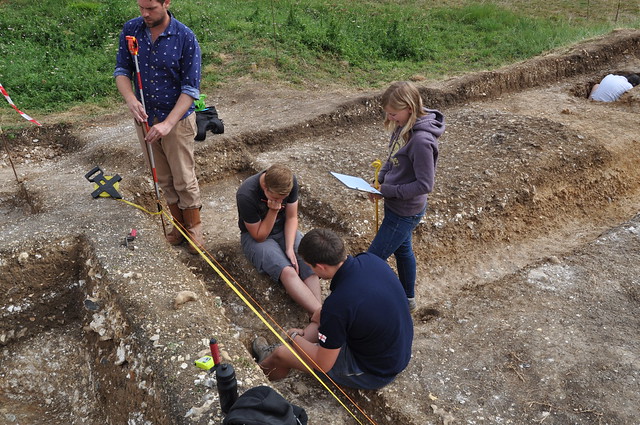
Callum, Jake and Corinne working on a section drawing, whilst Gareth surveys in the levels.
Over the past three weeks the site has been transformed from a rough patch of grass interspersed with nettles, thistles and other unpleasant plant life to a fully fledged, [after pictures 0702 (DX5000)] modern archaeological excavation with an open central section bordered by the remaining box excavations from the 1964 Aldermaston project. The first week consisted of the majority of the students and volunteers working hard to lift the turf and backfill material from the 1964 excavation whilst a small team worked round the upper levels to reveal the civil war chalk layer.
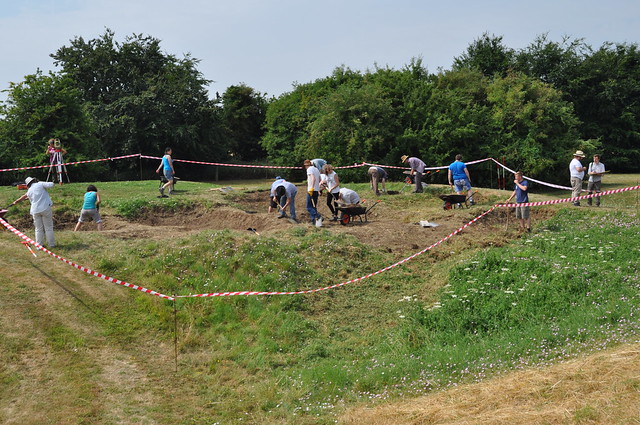
Looking back to day two of deturfing.
As the week progressed some finds started to emerge from the spoil and slump (material that has fallen in from the sides of the boxes) that had accumulated in the original box grid, amongst these and causing a great deal of excitement were sherds of what appeared to be 17th century slipware, it was only as the excavation continued and more of the slipware emerged that it became apparent that this was unlikely to be an original piece. This suspicion was confirmed when the base was discovered complete with the potters mark which revealed that it was a replica made for the Sealed Knot in the late 1970s to early 1980s and was probably lost on site during one of there visits. Other evidence of modern use of the site also emerged from this material in the form of a number of bottle caps, small animal bones, a lipstick cap, a beer can and a cider bottle. There was also a lot of evidence of burning in the form of ash both as what appear to be small camp fires and a large mass of burning filling one of the boxes (8A) completely. The week concluded with the discovery of a few of the survey pegs from the 1964 excavation.
As a reward for the work done clearing the turf and fill the entire team took the day off the site to visit Hampton Court Palace, this gave us a good chance to get an idea of what Basing House would have looked like at the height of its grandeur and importance.

Day trip to Hampton Court Palace.
Week two started much as week one finished with the removal of the final layers of the fill and hunting for the natural clay surface as recorded in the 1964 report. It was at this point that the top of the main East / West ditch was relocated in the position that the Aldermaston team had recorded. As the small team working in box 8A excavated down though the ditch fill,
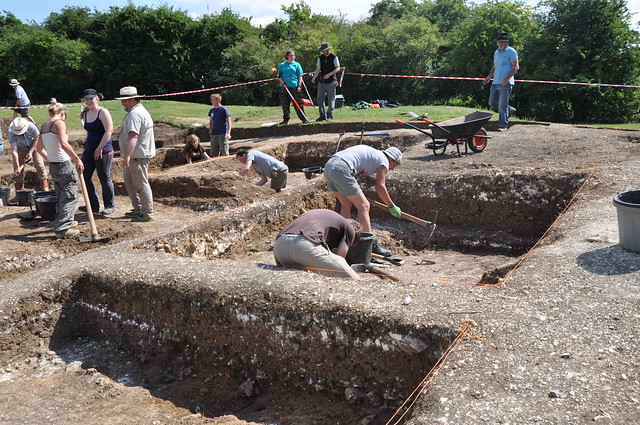
Eddie, excavating ditch fill.
they discovered the natural chalk bedrock that had not been reached in 1964, which represented a new layer of archaeology on the site. As the bottoms of the boxes were reached, the process of tidying up the sections and ensuring that the natural clay was located in all of them became the order of the day. This process allowed the feature found in box 10B to be viewed properly and identified as a sunken iron age sub-circular feature (possibly the floor of a round house recorded in the original 60’s excavation).
Work also started on tracing the East / West ditch through the rest of the site with work taking place next to the baulk between 8A and 9A to dig down into the ditch fill and further along where the original linier cut came into the box grid to identify the northern and southern edges of the ditch. This cleaning back of the linear trench revealed an unrecorded area of large flints as well as the edges of the ditch.
As week three dawned and we returned to the trench for the last push the process of recording started to get underway with section drawings taking place in 8A and 8Z.
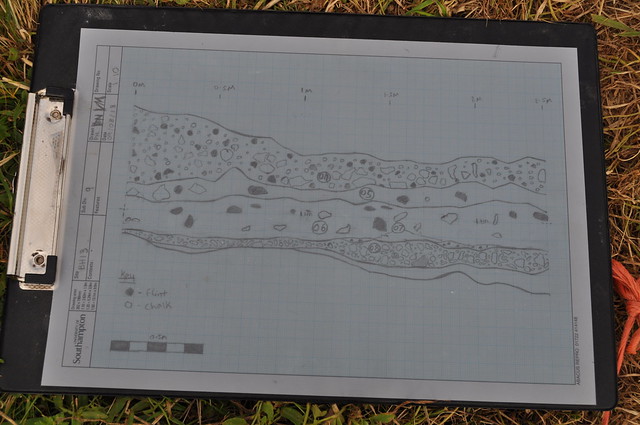
One of the many section drawings produced over the final few days on site.
It was during this process that we noticed that the eastern facing section had not been completely excavated and it was decided to chase the chalk line down to its lowest point. This also marked the stage of the excavation when it was decided to start scraping back some of the 1964 baulks

Scraping back the baulks.
to reveal new archaeology under them and to excavate the area of large flints that had been discovered in the slit trench.
At the end of the final day the overall impression from the site reveals the following, much of which appears to be able to confirm the findings of the 1964 excavation.
We must start by mentioning that Box 8B remained unexcavated but the floor of the ‘western round house’ (sunken Iron Age floor surface) appears to continue trough the baulk that separates 8A from 8B and the baulk between 8B and 9B.
8A contains evidence of the ‘round house’ in the base of the box, in the form of a cobbled floor and as fill to the depression it leaves in the baulk under the roman chalk and burnt flint floor surface, this roman surface may have been a threshing floor. This box also contains the only fully excavated section of the East / West
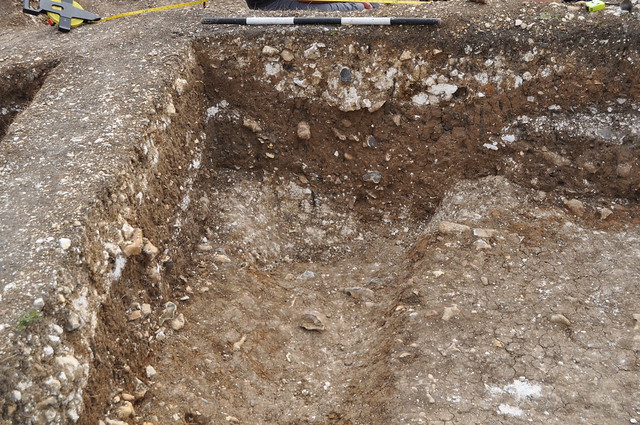
Fully excavated EW ditch.
ditch showing the chalk bedrock and total depth. The ditch clearly cuts through the roman floor and much of the material above this suggests that it is post roman. The uppermost chalk layer of the fill could be civil war in date as art of the activities to produce a level area. The North Facing baulk also shows evidence of the Pre-Civil War turf line but this peters out in the western facing baulk so does not exist in 8Z.
8Z shows the continuation of the depression of the Iron Age floor in its north facing section. This section also shows the roman chalk and burnt flint surface showing that it continued past the East / West ditch. This roman surface is also visible in the West Facing baulk but is not seen in the east facing baulk which would suggest that the corner of this surface would have been located in this box. The North Section also shows two suspected post holes that clearly cut the Iron Age Surface, one of the post holes has revealed a sherd of Roman Pottery. The northern half of 8Z is dominated by the cut of the Norman ditch
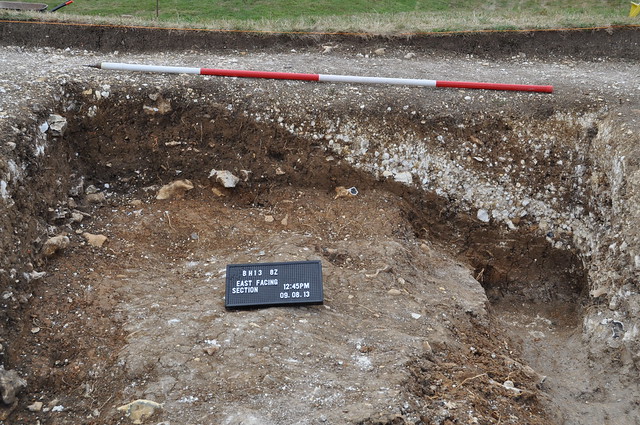
Norman ditch.
which remains not fully excavated due to its late discovery, though the cut is visible in full in the east facing section which was excavated to the base of the ditch.
9Z shows clear evidence of the surface of the roman burnt flint floor found in section in 8A. This floor is clearly cut by the East / West ditch.
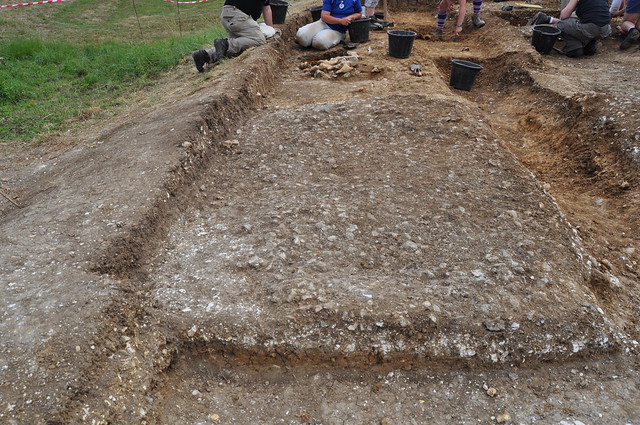
Burnt flint surface.
No new evidence has been gathered from 9A and 9B presumable due to the 1964 excavation digging through the roman floor.
The baulk between 9A and 8A shows evidence of two possible post holes as depressions in the underside of the roman chalk layer. This would place them inside the western round house.
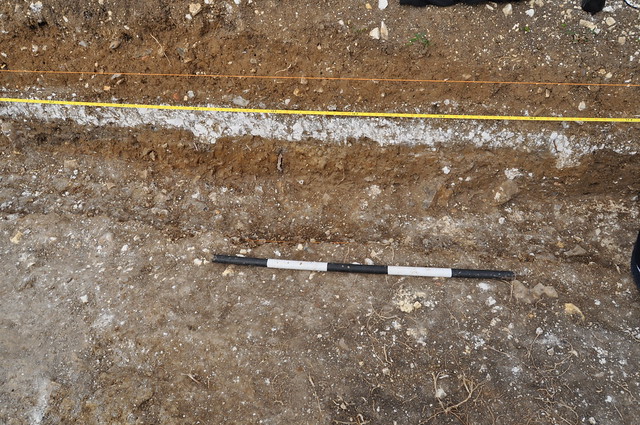
Postholes.
The Baulk between 9B and 10B revealed two large flint lined holes which may be Post Holes. Metal has been recovered from one of these features that may suggest that they are post roman.
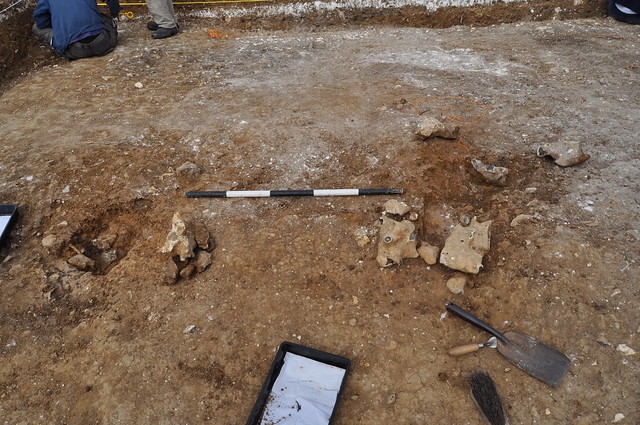
Postholes.
The baulk between 10B and 11B shows the floor of the eastern ‘Round House’ (sunken Iron Age floor surface) and shows a new layer that appears to have been cut by the ‘Round House’.
11B contains a suggestion of the corner of the eastern round house floor surface, this continues through the baulks to show a clear flint floor between 10B and 10A, as well as 11A and 11B.
10Z shows a very large flint lined pit that has been suggested as a large post hole however this is inconclusive due to the size and lack of evidence of the post or post tube.
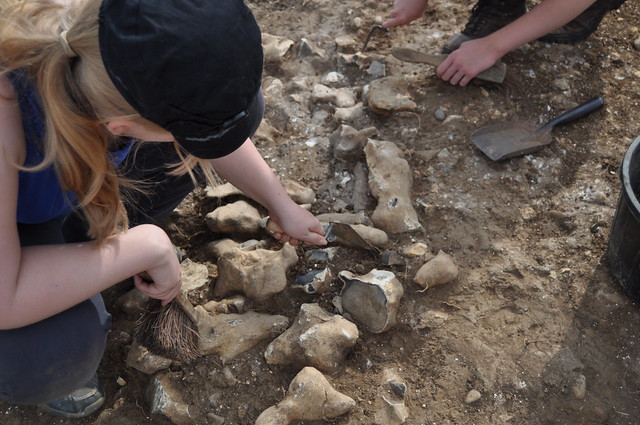
Liv beginning to excavate the flint feature.
Filed under: Archaeology of Archaeology, Day Eighteen, Student Reporter, Summer Excavation
